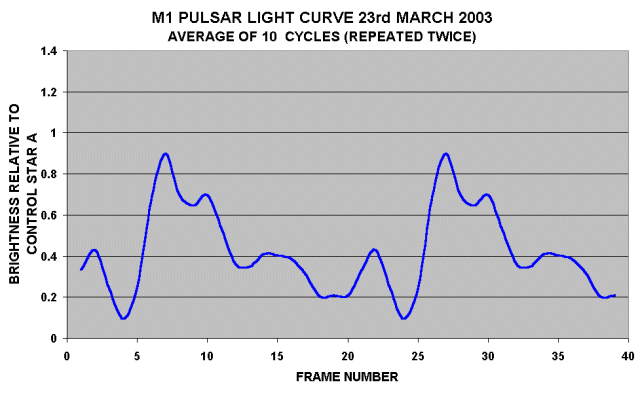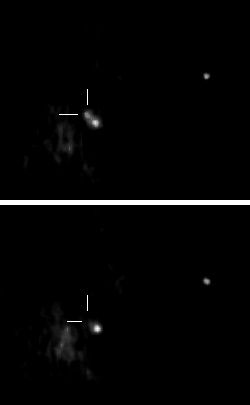
MEASURING AN OPTICAL PULSAR LIGHT CURVE
USING A STROBING TECHNIQUE
RUN 23rd March 2003
The strobe wheel was set running at a nominal frequency of 29.8Hz, slightly lower than the Pulsar frequency of 29.809Hz This should theoretically give approximately a 100sec per cycle strobe effect.
A 2000 second series of 200 10sec exposures was made. This was sufficient to detect the pulsar in each frame, but noise produced significant variations between consecutive exposures. To reduce the noise, a 5 exposure running mean series was produced. See animated gif (WARNING 900kb)! Note that North is up in this animation, ie inverted compared with the other images in this study.
There is some evidence of pulsations at 20 frame intervals in the series but general variations from exposure to exposure means that the pulsations are not obvious and at one point disappear into the background for a couple of cycles.
To reduce the noise further, the 10x 20 frame blocks from the original series (ie without a running mean applied) were averaged to produce a single cycle, with each frame being an average of 10 exposures. The brightness of the pulsar was then compared frame by frame with the adjacent comparison star A, identified in the image on the previous page . The resulting light curve is shown in the graph below (The graph shows the measured cycle repeated twice). There is evidence of the main pulse but not of the intermediate pulse. The cycle length is 200 seconds

5 frames each from the maximum and minimum positions on the curve have been averaged to produce the images below showing the pulsar on and off. The images are therefore each an average of 50 exposures. The average brightness of the control stars are very similar in each image but the pulsar brightness is significantly different.

The conclusion is that the longer run has confirmed the presence of cyclic variations in the Pulsar optical brightness and the average of the 10 cycles clearly shows variations in the pulsar compared with the surrounding control stars.
25th March 2003
FEEDBACK FROM QCUIAG CONFERENCE Q-2004 Feb 2004